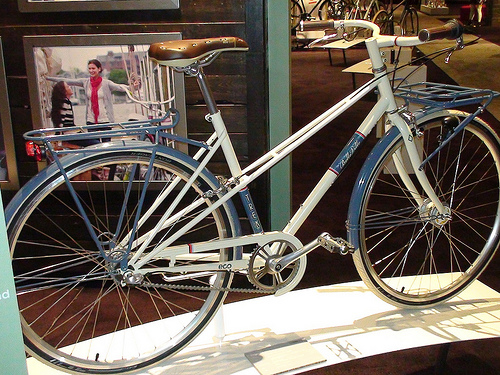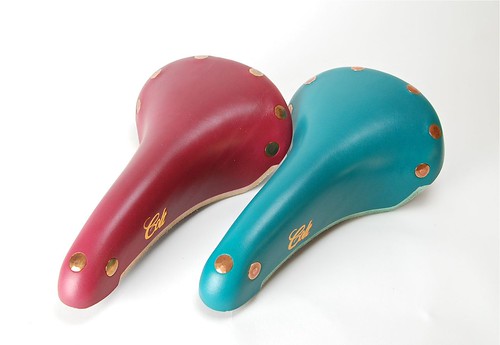For some time now, there has been debate as to whether the rise of "cycling culture" is positioning the bicycle as primarily a fetish object, with functionality a mere afterthought. As with any trend, the marketing industry harvests the readily identifiable, superficial aspects of a phenomenon, enhances them to the point of vulgarity, then sells to the eager public an attractive empty shell, devoid of any actual substance. BikeSnobNYC has been waxing lyrical on this topic since the start of his blog, satirizing a "bike culture" where sullen boys walk their brakeless neon fixies to the nearest cafes while airhead girls pedal their 70lb Dutch bikes at 5mph against traffic in billowing designer frocks - all of them laden with hundreds of dollars worth of cycling-specific accessories.
While I am accustomed to the Snob's endearing rants on this topic, reading Rivendell's version of the same complaint the other day was more novel. In several recent posts, Grant Petersen describes going to a bicycle trade show and being taken aback by the abundance of over-designed and impractical objects, such as rhinestone-encrusted lugs, heavy leather saddlebags and absurdly complicated toe clips. "A bag that weighs more empty than the contents it carries is quite a bag. A rack that shows off its beauty and never covers itself with a bag or basket is quite a rack. A bike and every part on it should serve a function." Agreed. But the irony of it - and I am sure Mr. Petersen is not blind to this irony - is that Rivendell played a role in these fancy/useless things being on the market today. Creating an interest in elaborate lugwork, leather, twine, and "old timey aesthetics" was a key part of Rivendell's marketing from the start. Now, it seems that the message has gotten away from them. Form is being imitated without substance.

"A bike should look only so fancy," Petersen writes. "There's a line. It's easy to cross it." Problem is, who draws that line, and where? Is it just one of those things where we know it when we see it? I am not against extravagance in the bicycle industry per se: Ultimately I think it's marvelous if "luxury bicycles" become status symbols instead of luxury cars and electronic gadgets. But I guess for me, it's important that the bicycle be designed for actual use and with longevity in mind first and foremost. If I see a diamond encrusted bike and it's a good bike - quality construction and finishing, comfortable, great handling - then its excess does not annoy me. It amuses me, but I don't get mad thinking "how dare they make a diamond encrusted bike." On the other hand, if I see a bike where all the money went into the embellishments and the bicycle itself is shoddy or ill-conceived, that does bother me quite a bit: At that point it's not a bicycle, but a "BSO" (Bike Shaped Object). It may be expensive, but to my eye it is no different from those horrid things sold for $60 at big box stores: not a functional bike, but a sad waste of resources and human labor.

Of course, all of this does not just apply to luxury bicycles. Often I see bikes in the $400-700 range, where it is so plain that the majority of the manufacturer's budget went into simulating the aesthetics of high-end bikes and then marketing the heck out of the product, while paying only scant attention to things like geometry, quality of construction, and component choice. These bicycles are designed to look good in catalogues, but not to benefit the cyclist. They are essentially disposable.

And I think the theme of disposability is also what's behind my dislike of the recent proliferation of leather saddles that come in neon colours and wild motifs. Admittedly I am being hypocritical here, because the saddles are well-made and perfectly functional - what's the harm in them being flamboyantly colourful or embossed with skulls and bones? I guess I feel that the styling trivialises a product that is made from an animal and is meant to last a long time. My intent is not to be political with the animal thing, but on a personal level I do feel bad when I see these new models. Will a cyclist really keep a neon saddle for the rest of their lives? For the next several years even? It seems to me that the flamboyant styling introduces an element of built-in obsolescence into a product that is otherwise intended to last. It's a contradiction in design that I find jarring.
The point where a bicycle-related product stops being merely fancy or trendy and becomes offensive is different for everyone; we'll never agree. Still, it can be interesting to evaluate one's personal parameters and to hear others' opinions. What's your view?

"A bike should look only so fancy," Petersen writes. "There's a line. It's easy to cross it." Problem is, who draws that line, and where? Is it just one of those things where we know it when we see it? I am not against extravagance in the bicycle industry per se: Ultimately I think it's marvelous if "luxury bicycles" become status symbols instead of luxury cars and electronic gadgets. But I guess for me, it's important that the bicycle be designed for actual use and with longevity in mind first and foremost. If I see a diamond encrusted bike and it's a good bike - quality construction and finishing, comfortable, great handling - then its excess does not annoy me. It amuses me, but I don't get mad thinking "how dare they make a diamond encrusted bike." On the other hand, if I see a bike where all the money went into the embellishments and the bicycle itself is shoddy or ill-conceived, that does bother me quite a bit: At that point it's not a bicycle, but a "BSO" (Bike Shaped Object). It may be expensive, but to my eye it is no different from those horrid things sold for $60 at big box stores: not a functional bike, but a sad waste of resources and human labor.

Of course, all of this does not just apply to luxury bicycles. Often I see bikes in the $400-700 range, where it is so plain that the majority of the manufacturer's budget went into simulating the aesthetics of high-end bikes and then marketing the heck out of the product, while paying only scant attention to things like geometry, quality of construction, and component choice. These bicycles are designed to look good in catalogues, but not to benefit the cyclist. They are essentially disposable.

And I think the theme of disposability is also what's behind my dislike of the recent proliferation of leather saddles that come in neon colours and wild motifs. Admittedly I am being hypocritical here, because the saddles are well-made and perfectly functional - what's the harm in them being flamboyantly colourful or embossed with skulls and bones? I guess I feel that the styling trivialises a product that is made from an animal and is meant to last a long time. My intent is not to be political with the animal thing, but on a personal level I do feel bad when I see these new models. Will a cyclist really keep a neon saddle for the rest of their lives? For the next several years even? It seems to me that the flamboyant styling introduces an element of built-in obsolescence into a product that is otherwise intended to last. It's a contradiction in design that I find jarring.
The point where a bicycle-related product stops being merely fancy or trendy and becomes offensive is different for everyone; we'll never agree. Still, it can be interesting to evaluate one's personal parameters and to hear others' opinions. What's your view?







0 comments:
Post a Comment